Vladimir, Russia
Vladimir (Russian: Владимир, IPA: [vlɐdʲi'mʲɪr] (![]()
Vladimir Владимир | |
|---|---|
City[1] | |
 Views of Vladimir | |
 Flag .png) Coat of arms | |
| Anthem: none[2] | |
Location of Vladimir 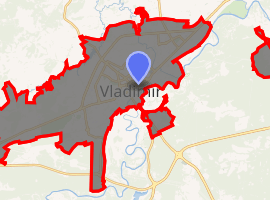
| |
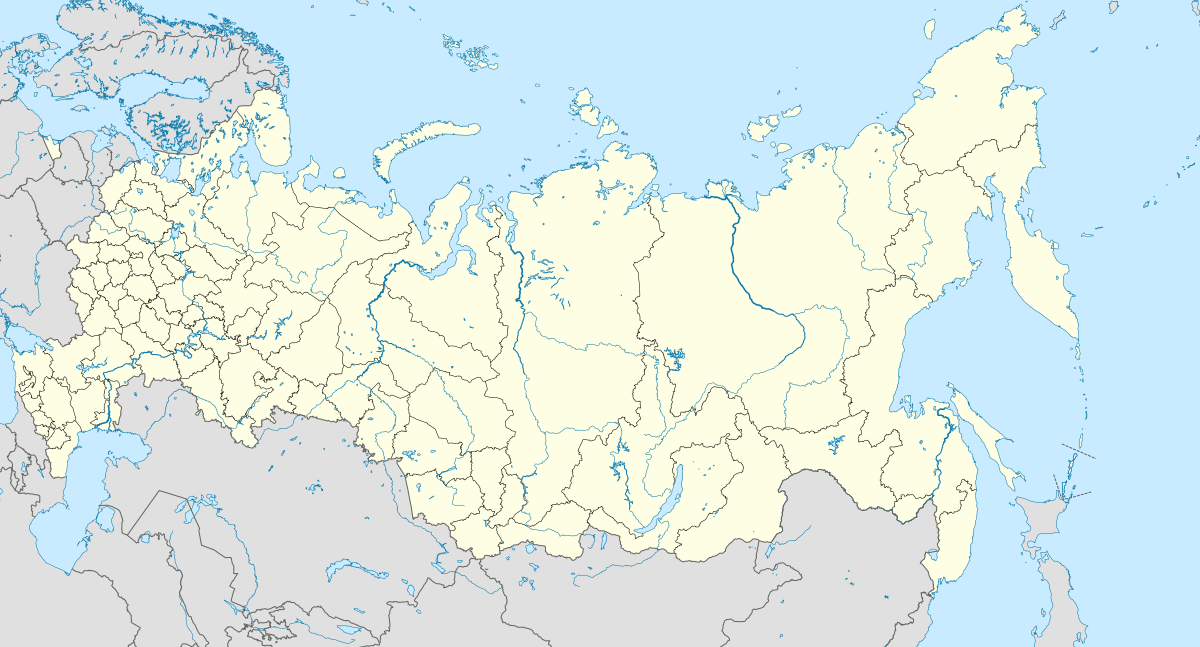 Vladimir Location of Vladimir  Vladimir Vladimir (Vladimir Oblast) | |
| Coordinates: 56°08′N 40°25′E | |
| Country | Russia |
| Federal subject | Vladimir Oblast[3] |
| Founded | 990 or 1108(see text) |
| Government | |
| • Body | Council of People's Deputies[4] |
| • Head[4] | Olga Deyeva[5] |
| Area | |
| • Total | 124.59 km2 (48.10 sq mi) |
| Elevation | 150 m (490 ft) |
| Population | |
| • Total | 345,373 |
| • Estimate (2018)[8] | 357,024 (+3.4%) |
| • Rank | 51st in 2010 |
| • Density | 2,800/km2 (7,200/sq mi) |
| • Subordinated to | City of Vladimir[3] |
| • Capital of | Vladimir Oblast[3], City of Vladimir[3] |
| • Urban okrug | Vladimir Urban Okrug[9] |
| • Capital of | Vladimir Urban Okrug[9] |
| Time zone | UTC+3 (MSK |
| Postal code(s)[11] | 600000, 600001, 600003, 600005–600009, 600014–600018, 600020–600028, 600031–600033, 600035–600038, 600700, 600950, 600960, 600970, 600980, 600999, 992800 |
| Dialing code(s) | +7 4922 |
| OKTMO ID | 17701000001 |
| City Day | The first Sunday of September |
| Website | www |
History
Vladimir was one of the medieval capitals of Russia, with significant buildings surviving from the 12th century. Two of its Russian Orthodox cathedrals, a monastery, and associated buildings have been designated as among the White Monuments of Vladimir and Suzdal, a UNESCO World Heritage Site. In the past, the city was also known as Vladimir-on-Klyazma (Владимир-на-Клязьме)[14] and Vladimir-Zalessky (Владимир-Залесский), to distinguish it from another Vladimir in Volhynia (modern Ukraine).
Foundation date controversy
Traditionally, the founding date of Vladimir has been acknowledged as 1108, as the first mention of Vladimir in the Primary Chronicle appears under that year. This view attributes the founding of the city, and its name, to Vladimir Monomakh, who inherited the region as part of the Rostov-Suzdal Principality in 1093. It is named there as Volodimer.[15] On the 17th centuries maps, it was identified as Wolodimer, while its region as Volodimer. Being established long after the city of Volodymyr in Volhynia, initially it was named Vladimir-on-Klyazma. In 1958, the 850th anniversary of the city foundation was celebrated, with many monuments from the celebrations adorning the city.
In the 1990s, a new opinion developed that the city is older than this. Scholars reinterpreted certain passages in the Hypatian Codex, which mentions that the region was visited by Vladimir the Great, the "father" of Russian Orthodoxy, in 990, so as to move the city foundation date to that year. The defenders of the previously uncontested founding year of 1108 dispute the claims of those who support the new date, arguing that the new theory was fabricated in order to provide a reason to have a celebration in 1995.
The neighboring town of Suzdal, for instance, was mentioned in 1024. Its 12th-century inhabitants alluded to Vladimir as a young town and treated its rulers with arrogance. In the words of a major chronicle, they said that the people of Vladimir were "their kholops and scions". In the seniority conflicts of the 12th and early 13th centuries, Vladimir was repeatedly described as a "young town" compared to Suzdal and Rostov. Nevertheless, the Charter of Vladimir, the basic law of the city passed in 2005, explicitly mentions 990 as the date of the city's foundation.[16]
Golden Age
The city's most historically significant events occurred after the turn of the 12th century. Serving its original purpose as a defensive outpost for the Rostov-Suzdal Principality, Vladimir had little political or military influence throughout the reign of Vladimir Monomakh (1113–1125), or his son Yury Dolgoruky ("Far-Reaching") (1154–1157).
.jpg)
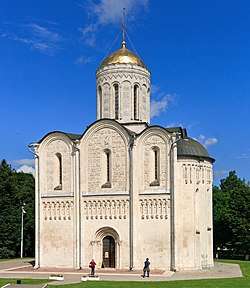
Under Dolgoruky's son, Andrey Bogolyubsky (1157–1175) (also known as Andrew the Pious), the city became the center of the Vladimir-Suzdal Principality. It had a Golden Age, which lasted until the Mongol invasion of Rus' in 1237. During this time, Vladimir enjoyed immense growth and prosperity. Andrey oversaw the building of the city's Golden Gates and the Dormition Cathedral. In 1164, Andrey attempted to establish a new metropolitanate in Vladimir, separate from that of Kiev. He was rebuffed by the Patriarch of Constantinople.[17]
Scores of Russian, German, and Georgian masons worked on Vladimir's white stone cathedrals, monastery, towers, and palaces. Unlike any other northern buildings, their exterior was elaborately carved with high relief stone sculptures. Only three of these edifices stand today: the Dormition Cathedral, the Cathedral of Saint Demetrius, and the Golden Gate. They are included among the White Monuments of Vladimir and Suzdal, designated as a UNESCO World Heritage Site. During Andrey's reign, a royal palace in Bogolyubovo was built, as well as the world-famous Church of the Intercession on the Nerl, now considered one of the jewels of ancient Russian architecture. Andrey was assassinated at his palace at Bogolyubovo in 1175.
Decline
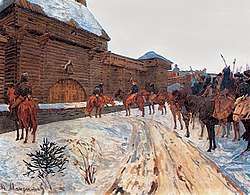
Vladimir was besieged by the Mongol-Tatars of the Golden Horde under Batu Khan. It was finally overrun on February 8, 1238. A great fire destroyed thirty-two limestone buildings on the first day alone, while the grand prince's family perished in a church where they sought refuge from the flames. The grand prince escaped, but was killed at the Battle of the Sit River the following month.
After the Mongols, Vladimir never fully recovered. The most important Ruthenian prince (usually the Prince of Moscow, but sometimes a Tver or another principality) was styled the Grand Prince of Vladimir, but the title had become an honorific symbol of majesty. From 1299 to 1325, the city was seat of the metropolitans of Kiev and All Rus', until Metropolitan Peter moved the See to Moscow in 1325.
The Grand Princes of Vladimir were originally crowned in Vladimir's Assumption Cathedral, but when Moscow superseded Vladimir in the 14th Century as the seat of the Grand Prince, the Assumption Cathedral in the Moscow Kremlin became the site of their coronation. The Moscow cathedral was loosely copied by the Italian architect Aristotele Fioravanti from Vladimir's original.
After the rise of Moscow, Grand Princes of Moscow continued to build several new churches in Vladimir. Notable examples include the Annunciation Church at Snovitsy (ca. 1501), three kilometers northwest of the city, and a church in the Knyaginin Nunnery (ca. 1505), which today includes murals dating from 1648.
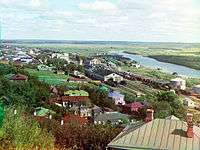
Remains of the prince-saint Alexander Nevsky were kept in the ancient Nativity Abbey of Vladimir until 1703, when Peter the Great had them transferred to the Monastery (now Lavra) of Alexander Nevsky in St. Petersburg. The Nativity Church (built from 1191 to 1196) collapsed several years later, after workmen tried to fashion more windows in its walls in an effort to brighten the interior.
The city was the center of Vladimir Province, part of Moscow Governorate from its establishment by Peter the Great in 1708. Vladimir was separated from Moscow Governorate and made the center of a new Vladimir Viceroyalty by a ukase of Catherine the Great in 1778. In 1796, Paul I's administrative reform transformed the viceroyalty into the Vladimir Governorate in the same borders.
In the years 1838-1840, Alexander Herzen was exiled in Vladimir, passing through the city on the infamous Vladimirka.
In December 1858 the city began to operate telegraph. On June 14, 1861,[18] the Moscow–Nizhny Novgorod Railway began to operate through Vladimir. In 1866, construction of a running water supply was completed, with telephone lines being put up in 1887 and the first electrical power lines on December 5, 1908.
In November 29, 1898 Vladimir provincial scientific archival commission was established.
Soviet period
After the establishment of Soviet power, many streets were renamed in Vladimir; most of the parish churches were closed and condemned to be demolished.
In the first decades of Soviet rule industrialization occurred in Vladimir. On January 14, 1929, the Vladimir Governorate was abolished and the city became part of the newly formed Ivanovo Industrial Oblast.
On August 14, 1944, Vladimir became the administrative center of a new Vladimir Oblast carved from Ivanovo Oblast. In 1950 from the basis of the teachers' institute the Vladimir Pedagogical Institute was created. On November 5, 1952 the first trolleybus line began to operate in the city.
In 1958 the Vladimir–Suzdal Museum and Reserve was created, composed of a group of unique architectural monuments of Russian defense and church architecture. The monuments are located in three cities—Vladimir, Suzdal and Gus-Khrustalny—as well as villages of Bogolyubovo and Kideksha.
Architecture of the Soviet period is represented by such structures as building complexes and polytechnic colleges, the Torpedo Stadium (built 1952), a reinforced concrete arch bridge over the river Klyaz'ma (1960), the Hotel Vladimir (1956), the Drama Theatre (1971) and others. In 1971 the city was awarded the Order of Red Banner of Labor.
Administrative and municipal status
Vladimir is the administrative center of the oblast.[3] Within the framework of administrative divisions, it is, together with seventeen rural localities, incorporated as the City of Vladimir—an administrative unit with the status equal to that of the districts.[3] As a municipal division, the City of Vladimir is incorporated as Vladimir Urban Okrug.[9]
Economy and military
Vladimir is home to several electrical and chemical factories, several food processing plants and two large thermal power stations. Tourism related to the historical sites is a major contributor to the city economy.
The headquarters of the 27th Guards Rocket Army of the Strategic Missile Troops is located in the city. During the Cold War, Vladimir was host to the Dobrynskoye air force base.
Transportation
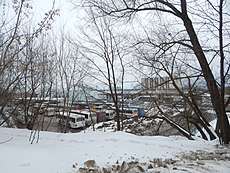
Since 1861, there has been a railway connection between Vladimir and Moscow.[19] Vladimir is also linked to Moscow and Nizhny Novgorod by the M7 highway. Local transport includes buses, trolleybuses, fixed-route minivans, and taxis.
Vladimir bus service links the city to all the district centers of Vladimir Oblast, as well as Moscow, Ivanovo, Kostroma, Nizhny Novgorod, Ryazan, Yaroslavl and other cities.
At least 20 pairs of long-distance trains pass daily through Vladimir station, giving Vladimir year-round direct rail links to Moscow (Kursk Station), St. Petersburg and Nizhny Novgorod. Since the summer of 2010 Vladimir (on the Nizhny Novgorod line) is a stopping point for the "Peregrine Falcon" high-speed train.
Developed suburban rail: Vladimir was the only city in Russia with concurrent commuter trains two Russian cities with subways. The city is served by the Semyazino Airport 5 km west of the city center.
 Vladimir railway station, August 2008
Vladimir railway station, August 2008.jpg) Trolleybus ZiU-9
Trolleybus ZiU-9 Trolza-5275 low-entry trolleybus
Trolza-5275 low-entry trolleybus A trolleybus route #1
A trolleybus route #1 A bus route #26
A bus route #26 The bus terminal in Vladimir
The bus terminal in Vladimir
Climate
Vladimir experiences a humid continental climate (Köppen climate classification Dfb) with long, cold winters and short, warm summers.
| Climate data for Vladimir | |||||||||||||
|---|---|---|---|---|---|---|---|---|---|---|---|---|---|
| Month | Jan | Feb | Mar | Apr | May | Jun | Jul | Aug | Sep | Oct | Nov | Dec | Year |
| Record high °C (°F) | 7.1 (44.8) |
9.5 (49.1) |
17.8 (64.0) |
27.8 (82.0) |
34.0 (93.2) |
34.4 (93.9) |
37.1 (98.8) |
36.5 (97.7) |
29.5 (85.1) |
25.0 (77.0) |
14.8 (58.6) |
9.2 (48.6) |
37.1 (98.8) |
| Average high °C (°F) | −5.6 (21.9) |
−5.0 (23.0) |
1.5 (34.7) |
10.9 (51.6) |
18.6 (65.5) |
22.1 (71.8) |
24.3 (75.7) |
22.0 (71.6) |
15.7 (60.3) |
8.0 (46.4) |
−0.4 (31.3) |
−4.4 (24.1) |
9.0 (48.2) |
| Daily mean °C (°F) | −8.5 (16.7) |
−8.5 (16.7) |
−2.5 (27.5) |
5.7 (42.3) |
12.6 (54.7) |
16.6 (61.9) |
18.8 (65.8) |
16.5 (61.7) |
10.8 (51.4) |
4.6 (40.3) |
−2.4 (27.7) |
−7.0 (19.4) |
4.7 (40.5) |
| Average low °C (°F) | −11.3 (11.7) |
−11.5 (11.3) |
−5.8 (21.6) |
1.4 (34.5) |
7.3 (45.1) |
11.8 (53.2) |
14.0 (57.2) |
12.1 (53.8) |
7.2 (45.0) |
2.1 (35.8) |
−4.7 (23.5) |
−9.4 (15.1) |
1.1 (34.0) |
| Record low °C (°F) | −39.7 (−39.5) |
−36.1 (−33.0) |
−30.0 (−22.0) |
−16.1 (3.0) |
−9.0 (15.8) |
−0.1 (31.8) |
3.9 (39.0) |
0.0 (32.0) |
−6.3 (20.7) |
−18.9 (−2.0) |
−27.2 (−17.0) |
−43.0 (−45.4) |
−43.0 (−45.4) |
| Average precipitation mm (inches) | 40 (1.6) |
30 (1.2) |
29 (1.1) |
33 (1.3) |
45 (1.8) |
78 (3.1) |
63 (2.5) |
62 (2.4) |
52 (2.0) |
61 (2.4) |
48 (1.9) |
44 (1.7) |
585 (23.0) |
| Average rainy days | 5 | 3 | 6 | 12 | 15 | 17 | 15 | 15 | 16 | 16 | 10 | 5 | 135 |
| Average snowy days | 26 | 23 | 16 | 6 | 1 | 0 | 0 | 0 | 1 | 6 | 18 | 25 | 122 |
| Average relative humidity (%) | 86 | 82 | 76 | 71 | 67 | 73 | 76 | 79 | 82 | 85 | 88 | 87 | 79 |
| Source: Pogoda.ru.net[20] | |||||||||||||
Sightseeing
Modern Vladimir is a part of the Golden Ring of ancient Russian cities and a popular tourist destination. Its three chief monuments, White Monuments of Vladimir and Suzdal, inscribed by UNESCO on the World Heritage List, are the following:
- The magnificent five-domed Dormition Cathedral was designed as the burial place of grand princes and dedicated to the holy icon the Theotokos of Vladimir, which had been brought to the city by Andrey Bogolyubsky. The cathedral was constructed in 1158–1160, expanded in 1185–1189, and painted by the great Andrei Rublev and Daniil Chyorny in 1408. In 1810, a lofty bell-tower was added in Neoclassical style.
- The helmet-domed Cathedral of Saint Demetrius was built in 1194–1197 as a private chapel of Vsevolod the Big Nest in the courtyard of his palace and was consecrated to his holy patron, St. Demetrius. For all its formal unity, the cathedral represents an international project of Russian and Byzantine masters, Friedrich Barbarossa's masons, and carvers sent by Queen Tamar of Georgia.
- The Golden Gate, originally a tower over the city's main gate, was built in 1158–1164. The gate acquired its present form after having been reconstructed in the late 18th century, to prevent the dilapidated structure from tumbling down.
Other remarkable monuments of pre-Mongol Russian architecture are scattered in the vicinity. For more information on them, see Suzdal, Yuriev-Polsky, Bogolyubovo, and Kideksha.
- View of Vladimir
- Public park in Vladimir
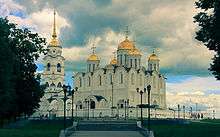 Assumption Cathedral
Assumption Cathedral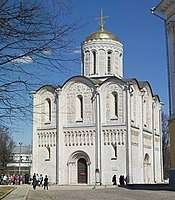 Cathedral of Saint Demetrius
Cathedral of Saint Demetrius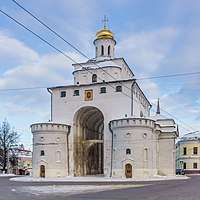 Golden Gate
Golden Gate
Education
Vladimir is the site of the following education establishments:
- Vladimir State University
- Vladimir branch of the Russian Academy of National Economy and Public Administration
- Vladimir branch of Financial University under the Government of the Russian Federation
- Vladimir branch of the Russian University of Cooperation
- Vladimir Law Institute under the Ministry of Justice
- Vladimir Business Institute
- Vladimir Aviation Mechanics College
- Vladimir Pedagogical College
- Vladimir Polytechnic College
- Vladimir Basic Medical College
- Vladimir Construction College
- Vladimir Regional College of Music
- Vladimir Economy and Technology College
- Vladimir College of Technology
- Vladimir Industrial College
- Vladimir Chemical and Mechanical College
- College of Innovative Technologies and Entrepreneurship at Vladimir State University
Vladimir is also home to the Federal Centre for Animal Health and Welfare.
Sports
The city association football team, FC Torpedo Vladimir, currently plays in the second tier of Russian football having entered the league after seventeen years of competing in Russian third and fourth tiers.
Vladimir VC (previously known as Skat and Dinamo Vladimir) represents the city in Volleyball Major League B – Zone Europe. Vladimir is also home to Polaris-Vladimir ice hockey club, which competes in regional hockey competitions and Russian minor leagues, and Luch, which has both male and female table-tennis teams.
Twin towns – sister cities
Vladimir is twinned with:[21]





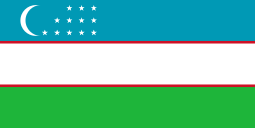










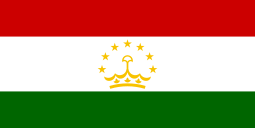






Notable people

- Valentin Afonin, association football player
- Yuri Lodigin, association football player
- Nikolai Andrianov, gymnast
- Vladimir Artemov, gymnast
- Aleksey Batalov, actor
- Mikhail Lazarev, admiral
- Yuri Levitan, radio announcer
- Anna Loginova, fashion model
- Alexey Prokurorov, cross-country skier
- Yuri Ryazanov, gymnast
- Vasily Shulgin, politician
- Mikhail Speransky, statesman
- Aleksandr Stoletov, physicist
- Nikolai Stoletov, general
- Sergei Taneyev, composer
- Dmitri Vyazmikin, association football player
- Venedikt Yerofeyev, writer
- Denis Yevsikov, association football player
- Nikolay Zhukovsky, scientist
References
Notes
- Resolution #433
- Article 7 of the Charter of Vladimir states that the city may have an anthem, providing a decision is reached by the Council of People's Deputies. As of 2015, no such decision has been made.
- Law #130-OZ
- Charter of Vladimir, Article 23
- Official website of Vladimir. Olga Alexandrovna Deyeva, Head of the City of Vladimir (in Russian)
- Управление Федеральной службы государственной регистрации, кадастра и картографии по Владимирской области. Доклад о состоянии и использовании земель Владимирской области в 2011 году. Город Владимир, форма 22 (in Russian)
- Russian Federal State Statistics Service (2011). "Всероссийская перепись населения 2010 года. Том 1" [2010 All-Russian Population Census, vol. 1]. Всероссийская перепись населения 2010 года [2010 All-Russia Population Census] (in Russian). Federal State Statistics Service.
- "26. Численность постоянного населения Российской Федерации по муниципальным образованиям на 1 января 2018 года". Federal State Statistics Service. Retrieved January 23, 2019.
- Law #189-OZ
- "Об исчислении времени". Официальный интернет-портал правовой информации (in Russian). June 3, 2011. Retrieved January 19, 2019.
- Почта России. Информационно-вычислительный центр ОАСУ РПО. (Russian Post). Поиск объектов почтовой связи (Postal Objects Search) (in Russian)
- Russian Federal State Statistics Service (May 21, 2004). "Численность населения России, субъектов Российской Федерации в составе федеральных округов, районов, городских поселений, сельских населённых пунктов – районных центров и сельских населённых пунктов с населением 3 тысячи и более человек" [Population of Russia, Its Federal Districts, Federal Subjects, Districts, Urban Localities, Rural Localities—Administrative Centers, and Rural Localities with Population of Over 3,000] (XLS). Всероссийская перепись населения 2002 года [All-Russia Population Census of 2002] (in Russian).
- "Всесоюзная перепись населения 1989 г. Численность наличного населения союзных и автономных республик, автономных областей и округов, краёв, областей, районов, городских поселений и сёл-райцентров" [All Union Population Census of 1989: Present Population of Union and Autonomous Republics, Autonomous Oblasts and Okrugs, Krais, Oblasts, Districts, Urban Settlements, and Villages Serving as District Administrative Centers]. Всесоюзная перепись населения 1989 года [All-Union Population Census of 1989] (in Russian). Институт демографии Национального исследовательского университета: Высшая школа экономики [Institute of Demography at the National Research University: Higher School of Economics]. 1989 – via Demoscope Weekly.
- Vladimir-on-Klyazma at the Brockhaus and Efron Encyclopedic Dictionary.
- Larin, S. (January 1, 1958). "Gorod Vladimir [1108-1958]: istoriko-ėkonomicheskiĭ ocherk" (in Russian). Владимирское книжное изд-во. Cite magazine requires
|magazine=(help) - Charter of Vladimir, Article 3.
- Janet Martin, Medieval Russia: 980-1584 (Cambridge: Cambridge UP, 1995), 100.
- http://eng.rzd.ru/statice/public/en?STRUCTURE_ID=4332&layer_id=4516&refererLayerId=4516&id=2554
- Train Station in Vladimir (in Russian)
- "Weather and Climate - Vladimir Climate" (in Russian). Weather and Climate (Погода и климат). Retrieved April 11, 2016.
- "От Усти-на-Лабе до Карлово: зачем Владимиру города-побратимы?". provladimir.ru (in Russian). Pro Vladimir. August 6, 2019. Retrieved February 2, 2020.
Sources
- Администрация Владимирской области. Постановление №433 от 13 июня 2007 г. «О реестре административно-территориальных образований и единиц Владимирской области», в ред. Постановления №169 от 5 марта 2015 г. «О внесении изменения в Постановление Губернатора области от 13.06.2007 №433 "О реестре административно-территориальных образований и единиц Владимирской области"». Вступил в силу со дня официального опубликования. Опубликован: "Владимирские ведомости", №114, 20 июня 2007 г. (Administration of Vladimir Oblast. Resolution #433 of June 13, 2007 On the Registry of the Administrative-Territorial Formations and Units of Vladimir Oblast, as amended by the Resolution #169 of March 5, 2015 On Amending Resolution #433 of the Oblast Governor of June 13, 2007 "On the Registry of the Administrative-Territorial Formations and Units of Vladimir Oblast". Effective as of the day of the official publication.).
- Законодательное Собрание Владимирской области. Закон №130-ОЗ от 10 декабря 2001 г. «Об административно-территориальном устройстве Владимирской области и о порядке его изменения», в ред. Закона №22-ОЗ от 18 марта 2014 г. «О признании утратившими силу части 1 статьи 15 Закона Владимирской области "Об административно-территориальном устройстве Владимирской области и о порядке его изменения" и пункта 3 статьи 1 Закона Владимирской области "О внесении изменений в Закон Владимирской области "Об административно-территориальном устройстве Владимирской области и о порядке его изменения"». Вступил в силу со дня официального опубликования (13 декабря 2001 г.). Опубликован: "Владимирские ведомости", №232, 13 декабря 2001 г. (Legislative Assembly of Vladimir Oblast. Law #130-OZ of December 10, 2001 On the Administrative-Territorial Structure of Vladimir Oblast and on Procedures for Its Change, as amended by the Law #22-OZ of March 18, 2014 On Abrogating Part 1 of Article 15 of the Law of Vladimir Oblast "On the Administrative-Territorial Structure of Vladimir Oblast and on Procedures for Its Change" and Item 3 of Article 1 of the Law of Vladimir Oblast "On Amending the Law of Vladimir Oblast "On the Administrative-Territorial Structure of Vladimir Oblast and on Procedures for Its Change". Effective as of the day of the official publication (December 13, 2001).).
- Законодательное Собрание Владимирской области. Закон №189-ОЗ от 26 ноября 2004 г. «О наделении статусом городского округа муниципального образования город Владимир Владимирской области», в ред. Закона №108-ОЗ от 10 августа 2009 г «О внесении изменений в Закон Владимирской области "О наделении статусом городского округа муниципального образования город Владимир Владимирской области"». Вступил в силу со дня официального опубликования (1 декабря 2004 г.). Опубликован: "Владимирские ведомости", №333, 1 декабря 2004 г. (Legislative Assembly of Vladimir Oblast. Law #189-OZ of November 26, 2004 On Granting Urban Okrug Status to the Municipal Formation of the City of Vladimir of Vladimir Oblast, as amended by the Law #108-OZ of August 10, 2009 On Amending the Law of Vladimir Oblast "On Granting Urban Okrug Status to the Municipal Formation of the City of Vladimir of Vladimir Oblast". Effective as of the day of the official publication (December 1, 2004).).
- Владимирский городской Совет народных депутатов. Решение №231 от 29 июня 2005 г. «Устав муниципального образования город Владимир», в ред. Решения №157 от 26 августа 2015 г. «О внесении изменений в Устав муниципального образования город Владимир». Вступил в силу 4 августа 2005 г. (за исключением отдельных положений, вступающих в силу в иные сроки). Опубликован: "Владимирские ведомости", №251–252, 4 августа 2005 г. (Vladimir City Council of People's Deputies. Decision #231 of June 29, 2005 Charter of the Municipal Formation of the City of Vladimir, as amended by the Decision #157 of August 26, 2015 On Amending the Charter of the Municipal Formation of the City of Vladimir. Effective as of August 4, 2005 (except for certain clauses which take effect on different dates).).
Further reading
- Trudy Ring, ed. (1995). "Vladimir". International Dictionary of Historic Places: Northern Europe. FitzroyDearborn. ISBN 978-1-136-63944-9. Retrieved April 4, 2016.
- Craft Brumfield, William (2004). A History of Russian Architecture. Seattle: University of Washington Press. ISBN 978-0-295-98394-3.
External links
| Wikivoyage has a travel guide for Vladimir. |